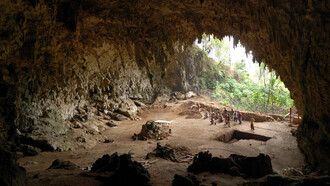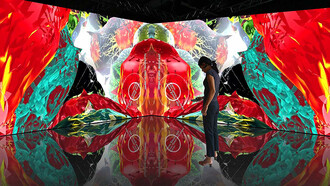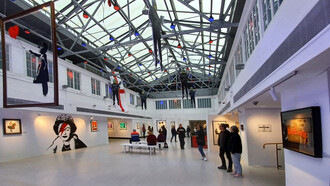Alastair Carew-Cox and William Waters’ photographic books on Victorian and Pre-Raphaelite stained glass are the ultimate resources on the subject. The three-volume oeuvre allows the reader to explore every aspect of their journey, through a comprehensive overview of all the locations they visited and their unprecedented discoveries. Angels & Icons, Damozels & Deities and the recently published Saints & Symbols are masterpieces in their own right and we were happy to discuss them and future developments with Carew-Cox.
Yours has been a very long journey unveiling Pre-Raphaelite stained glass. When and how did it begin?
In the 1990's I was commissioned, as an architectural photographer, to photograph Edward Burne-Jones' stained glass masterpiece in St. Philip's Cathedral, Birmingham. At the time I still used a 5"x4" Plate Camera where I had to cover my head with a cloth. To get the details I wanted I had to build two tower scaffolds, one over the altar and one in front of the West Window. I was surprised when Peter Berry, The Provost of the Cathedral, agreed until I discovered that he was the Founder and President of The Pre-Raphaelite Society.
Just getting my huge camera and tripod onto the platform at the top of the tower was an achievement, but being up close to these magnificent works of art was well worth it. Unfortunately, at the time, the Cathedral shop was in the west end and two very elderly volunteers would often knock into the scaffolding. When you are 40 feet up in the air it felt like a tidal wave! The exposures were over one minute long so I had to hold my breath anyway.
I was then asked by the head teacher of King Edward's School, Edgbaston, where Burne-Jones had been educated, to produce a booklet to commemorate the centenary of Burne-Jones' death in 1998. A mutual friend introduced me to the art historian and world expert on Pre-Raphaelite glass William Waters, who agreed to write the booklet. We have been working together now, researching and photographing Pre-Raphaelite Stained Glass, for nearly 25 years, and regard and present stained glass as a Fine Art. I travel thousands of miles each year, around the United Kingdom, photographing stained glass. This often entails having rural churches opened especially.
Bill Waters and I had produced the two volumes, Angels & Icons and Damozels & Deities and were thinking of producing a third volume on artists on the periphery of the movement who were perhaps better known for other things. Ford Madox Brown had started work as a stained glass designer for William Morris but became better known as a painter. Walter Crane was well known as a Victorian illustrator but his stained glass was little known and little researched. Bill had studied the work of J.G. Sowerby and Frederic Shields for many years and it seemed they would all make a good match for the book.
I was commissioned, by the author Adrian Barlow, to take the photographs for his book on the stained glass of Charles Eamer Kempe. (This has now been published, entitled Espying Heaven and it is superb). While visiting a remote country church in Feock, in Cornwall, to photograph a Kempe window, I was struck by the east window. I had no idea who it was by but photographed it anyway. Our research showed it to be a late and little known window by William De Morgan. He was someone that Bill had also been researching, on and off, for most of his life and he became the fifth and probably most important artist to be featured in the third volume.
What are the discoveries you are particularly proud of?
In the course of our work we have made many discoveries and hopefully changed the thinking on stained glass as an art form and on the output of the designers. Looking closely at my photographs of Feock I realised that the glass in the tracery was not by De Morgan and this puzzled me. I eventually decided to go back to the church, a nine hour round trip, as we had also found out that the church in the next village might have glass by De Morgan. Looking carefully around St. Feoca I suddenly realised that at the top of a west wall window were four lights, the Evangelists, pretty much the same size as the tracery lights of the east window and they were indeed by De Morgan. They must have been moved at some point. It is moments like this, discovering unknown glass by such a well-known name, that make the hours and hours of travelling all worthwhile. Also, the church in the next village, Gwennap, did indeed have De Morgan glass, all featured in Saints & Symbols.
On another occasion, Bill telephoned me to say that he had found out that some De Morgan cartoons were coming up at auction. The auctioneers kindly allowed me to photograph them. One of them was a very small watercolour, quite crude, with the words “Mr Dimmock's window” in pencil. What this was or where it might be was anybody's guess. Bill spent a lot of time researching it and came up with a potential church in Staffordshire. I contacted the church warden who said that there was no window like I described and that images of all the glass were on their website. Bill, however, was insistent so I contacted the church warden again. She kindly agreed to meet me (yet more driving), and she opened up the church. There, on the north wall, was an unknown De Morgan window, somehow missed off the church website. It took my breath away. The quarry tiles were absolutely gorgeous, so much so that I used them as endpapers in Saints & Symbols.
I worked closely with The De Morgan Foundation who allowed me to photograph their collection of unpublished cartoons, often alongside images of the actual glass. A really important section of Saints & Symbols. One of the cartoons, An Old Testament King, led to more discoveries, perhaps the most important research in the book. Bill had thought for some years that De Morgan had been a much more important designer for Morris, Marshall, Faulkner & Co. than had been previously credited. This cartoon was virtually the same as King David in a window in All Saints, Middleton Cheney, which we can now safely say is by De Morgan. Other panels in the window and some of those in St. Stephen's, Guernsey, we now know to be by De Morgan, working alongside Ford Madox Brown, William Morris and Edward Burne-Jones.
What do you think are the challenges of architectural photography and can you tell us more about your future projects from that perspective?
There are many challenges to photographing stained glass. I now use a Canon digital camera with tilt and shift lenses, which helps to correct perspective, although lighting is key with a very tall ladder and tripod being useful. Finding a key holder can be a challenge. I could not find the contact details for an important Walter Crane church in London, which necessitated a five hour round trip just to see if I could get in. Luckily there was someone in the graveyard who knew where the church warden would be. Again, it was all well worth it, the glass is extraordinary and features over many pages of Saints & Symbols. I get some strange looks as I carry my telescopic rainbow coloured feather duster through rural villages, while the costs of travel, research and bed and breakfast can be prohibitive. The cost of printing each book also runs into thousands and thousands of pounds so we set up crowd funding appeals to help towards the costs. We also spend a lot of time approaching institutions and Foundations such as The Marc Fitch Fund and Paul Mellon Foundation for financial support. This kind of work could not be done without their help.
Are you planning on publishing more volumes? If so, what aspects would you like to research?
Bill Waters and I are currently working on a book on the stained glass of the late Christine Boyce a designer who lived near Lanercost Priory in Cumbria. The Priory has one of her windows in it which sits alongside glass by Edward Burne-Jones and a dossal by William Morris. She produced some wonderful modern glass, her Norman Nicholson window in St. George's, Millom is a joy to behold.
I am hoping to produce a website featuring my photographs of the stained glass of A.W.N. Pugin and the scholarly research of the late Stanley A. Shepherd. It will feature an astonishing Gazetteer of all of Pugin's known stained glass with a description by Stanley of every window as well as Pugin's comments and letters concerning each window from the 1840's. I have photographed the glass in a convent in Edinburgh, had a disused church in Wales unlocked for me and even had a mausoleum in Devon opened up for the first time in years. It will be available without charge to scholars, students and the public as a lasting memory to Stanley. I am in the process of setting up a crowd funding appeal to raise funds for the website.
Furthermore, Bill Waters and I are currently planning a volume on the stained glass of William Morris. Surprisingly there are no books on his designs for stained glass, although, of course, certain windows are touched upon in general books on Morris & Co. He is underestimated as a figurative designer and we aim to put that right. As in all our books, we aim to encourage the conservation of stained glass and lead to more people understanding and enjoying this neglected art form.















